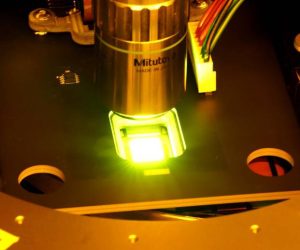
Towards these triple goals, Fraunhofer Institute for Photonic Microsystems (IPMS) has developed a novel way to stack OLEDs “introducing a highly efficient monochrome OLED microdisplay with a brightness of over 70,000 nits [70,000cd/m2]”, it said. “The OLED stack used even achieves over 200,000 nits on reference substrates.”
One, two and three-level OLED stacks were evaluated on passive substrates, and also on 0.62-inch (~16mm) SXGA (1,024 x 1,280) CMOS backplanes.
The vertically-aligned pixels are series connected, increasing light intensity without reducing lifetime as current density remains the same, although at the expense of operating voltage.
“Measurements have shown that, when comparing a one-unit and a two-unit OLED, LT95 [life to 5% intensity loss] at 50,000 nits can be improved from 900 to 1,300 hours,” said project researcher Johannes Zeltner.
The work has shown that stacking allows narrow-band emissions to be created, and that spectra can be customised for specific requirements such as driving waveguides or for holographic elements.
But not all is plain sailing.
“New challenges have emerged,” according to the Fraunhofer. “While conventional OLED displays often have several tens of micrometers between subpixels, in microdisplays it is only a few hundred nanometers. This can lead to crosstalk between adjacent pixels in thicker layer stacks and multiple stacked OLEDs in microdisplays. Approaches to reduce this crosstalk are in preparation.”
Fraunhofer IPMS is seeking partners to commercialise its technology, and will presented findings at SPIE AR VR MR in San Francisco – 28 and 29 January 2025, stand 6202.
 Electronics Weekly
Electronics Weekly



